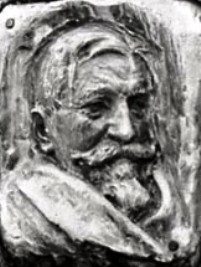Royal Emerson Whitman facts for kids
Quick facts for kids
Royal Emerson Whitman
|
|
|---|---|

Royal Emerson Whitman, from his monument at Arlington National Cemetery.
|
|
| Born | May 11, 1833 Turner, Maine |
| Died | February 12, 1913 (aged 79) Washington, D.C. |
| Place of burial | |
| Allegiance | US |
| Service/ |
United States Army Union Army |
| Years of service | 1862–65, 1867–79 |
| Rank | Colonel, USV First Lieutenant, USA |
Colonel Royal Emerson Whitman (May 11, 1833 – February 12, 1913) was an American army officer. He served in the Civil War, during the Reconstruction period, and in the Indian Wars. He is known for his connection to the 1871 Camp Grant massacre.
Contents
Early Life and Family
Royal Emerson Whitman was born on May 11, 1833, in Turner, Maine. His parents were Royal and Sally (Bradford) Whitman. Before joining the army, he made saddles.
He married Lucretia Octavia Whitman on December 1, 1852. She was also from Maine. They lived in Portland and Turner, Maine. They had six children: Alice, Alphonso, Royal, William Ross, Henry Hyde, and May.
Military Service
Whitman began his military career in the American Civil War. He joined the 23rd Maine Volunteer Infantry in 1862. He became a sergeant major and then a captain. He left the volunteer service in 1863.
He rejoined in December 1863 with the 30th Maine Volunteer Infantry. He was promoted to major, then lieutenant colonel, and finally colonel. He left the volunteer service for good in August 1865.
In 1867, he joined the 3rd U.S. Cavalry as a second lieutenant. He was recognized for his bravery during the Battle of Sabine Crossroads in 1864. He became a first lieutenant in 1869. Whitman retired from the army on March 20, 1879.
Working for Peace at Camp Grant
In 1871, Lieutenant Whitman, then 37 years old, took command of Camp Grant. This camp was located near the San Pedro River and Aravaipa Creek. The area was once home to the Aravaipa Apache people.
In February 1871, some elderly Apache women came to Camp Grant. They were looking for a son who had been captured. Whitman was kind to them and gave them food. Because of his kindness, more Apache people from the Aravaipa and Pinal bands came to the camp.
Whitman gave them food like beef and flour. He also helped them find work as farmhands for local ranchers. The Apache people promised not to take part in any raids. That spring, Whitman created a safe place for nearly 500 Aravaipa and Pinal Apaches. This camp was along Aravaipa Creek, near Camp Grant. Chief Eskiminzin was among them.
Whitman worried that the peace might not last. Other Apache groups were still raiding, and sometimes the Aravaipa at Camp Grant were blamed. He suggested that Eskiminzin move his people to the White Mountains. This area was near Fort Apache. However, Eskiminzin did not want to move.
The Camp Grant Attack
On April 30, 1871, a group of people from Tucson attacked the Apache camp. They were joined by O'odham mercenaries. The attackers killed 144 people. Most of those killed were women and children. The Apache men were away hunting in the mountains. This attack happened because of a raid by another Apache group. In that raid, six people were killed and some animals were stolen.
Twenty-seven Apache children were captured during the attack. They were later sold in Mexico by the O'odham.
Lieutenant Whitman searched for anyone who was hurt. He found only one woman alive. He then buried the dead. He sent people to find the Apache men in the mountains. He wanted to assure them that his soldiers were not part of the attack. The next evening, the Apache survivors slowly returned to Camp Grant. Many settlers in southern Arizona thought the attack was justified.
A local businessman, William Hopkins Tonge, called the event a "massacre." He wrote to the Commissioner of Indian Affairs. He said the Apache were surprised and felt safe, so they had few weapons.
President Ulysses S. Grant demanded a trial for the attackers. He said he would send the army if the governor did not act. Later that year, a trial was held. The jury took only 19 minutes to find the more than 100 people accused not guilty.
Later Life
Royal Emerson Whitman retired from the army in 1879. He later lived in Washington, D.C.. He passed away on February 12, 1913, at the age of 79. His funeral was held on February 14, 1913. He was buried at Arlington National Cemetery.

